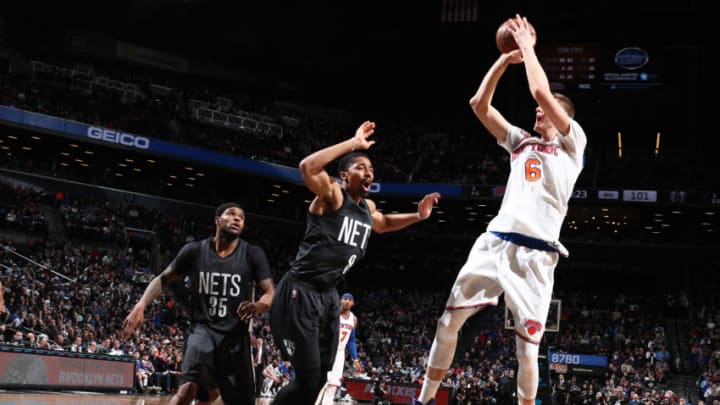In the hours leading up to the NBA draft, the Boston Celtics and the New York Knicks were reportedly in serious talks regarding Knicks big man Kristaps Porzingis. The now ousted Phil Jackson created a public feud with the budding star, who seemed unhappy in New York.
Since then, Porzingis has reaffirmed his commitment to the Knicks, saying it is “now home”. New York, for its part, has abandoned its insane quest to trade its shiniest doubloon. The waters have calmed down.
But don’t forget how things work in the NBA. One minute, Cleveland was stable; the next, it was taking phone calls for its 2nd best player, Kyrie Irving. Paul George, Jimmy Butler, DeMarcus Cousins, Chris Paul, and Gordon Hayward have all switched teams in just a short few months. Don’t count anything out in the tumultuous NBA; don’t count anything out when the New York Knicks are involved. Porzingis was upset enough to skip his exit meeting – whatever was wrong didn’t just magically resolve itself.
While New York and Porzingis enter the third year of their partnership, Boston will be there, still in prime position to make a move (assuming they don’t pull off a mega deal for Kyrie Irving by then…who could also be swapped with Porzingis if Cleveland’s hand is forced. So much for calm water).
This could very well still happen.
Where would Porzingis take the Celtics? Well, that depends on a lot of things. We don’t really know what Porzingis is yet. He has played his whole career in New York’s confusing offensive scheme, which has teetered between inefficient and underdeveloped to…triangular, depending on how moody the Zen Master was feeling that week.
At least in part thanks to that scheme, we have yet to see Porzingis as a great offensive player. He is a bad post scorer and a bad isolation scorer (in the 22nd and 25th percentiles, respectively through March of last season, per Bleacher Report). He doesn’t create for teammates, at least not directly (career 1.4 assists per game, with virtually no improvement from his first year to his second). While considered the modern incarnation of Dirk Nowitzki by many, his shooting numbers don’t back up the hype. He shot a forgettable 33% from distance in his first season, and an improved but not great 36% last year. That’s fine – if he shot that for his career, he’d become a very rich man. But it’s not the stuff of a transcendent mythical creature; again, the Knicks’ scheme owns much of the blame, but without evidence of how he would perform in a healthy system, this is all we have to go off of.
On defense, Porzingis is a mixed bag. As a rim protector, he is nothing short of elite. Opponents attempting shots from less than six feet shoot 49.3 percent against him; that’s right up there with Draymond Green and Rudy Gobert, largely considered the two best defensive big men in the league (if you call the endlessly versatile Draymond Green a big man – he’s the real unicorn). That’s with Derrick Rose and Carmelo Anthony containing perimeter threats. In a nutshell, he’s very good at protecting the rim.
Yet Porzingis, like many big men, lacks lateral mobility; at 7’3, he does not have the mobility to contain perimeter threats when he gets caught after a switch in the pick and roll. Similar big men (Jonas Valanciunas, for instance), who are elite next to the rim but struggle at the perimeter, often get benched in big moments. Switch-ability on defense is valued above all else in the modern NBA, and that is one area Porzingis struggles. (Some scouts think that a contributing factor is being caught out of position and not being completely dialed in, things that should improve with age. He will likely never be elite in this regard, but there is reason for optimism.)
This isn’t meant to bash Porzingis. He is a fine player, and a very young one at that. His shooting should improve (he already has comfort bombing from Steph Curry-land, even if his percentage leaves something to be desired). His assist numbers will improve.
And here’s the thing: if he were to find his way to Boston, he would likely flourish in this system. Brad Stevens could use him as a screen man on pick and pops, his most natural offensive utility, or could even run him off screens. Porzingis barely holds onto the ball – usually opting to shoot or pass quickly – making him a perfect system player.
In a Boston offense that bordered on elite featuring smart playmakers all over the floor, he’d see more open looks than he could ever imagine in New York.
On defense, his profile actually lines up spectacularly with Boston’s needs. They have good stoppers on the perimeter, but sorely lack a rim protector. While Porzingis would still be targeted in the pick and roll, he could be hidden better than in New York thanks to Marcus Smart, Jae Crowder, and the rest of Boston’s ball-swiping brigade, and his shot-blocking ability would be on full display.
Questions remain. Will Porzingis become more durable as his body develops? Will he ever become a facilitator? How much will his defensive weaknesses limit the impact of his strengths? But know this – if all hell breaks loose in New York (and it probably will; this is the Knicks we’re talking about), Danny Ainge will be there, assets in hand.
Fear the horn.
